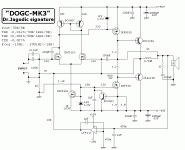O.k., i understand it now partially. It is better than mine in the regard, that power transistors have Vorspannung (bias voltage) due to idle current flowing thru 1.2 Ohms resistors. Yet it seems to depend on a lot of feedback, and MOSFETs do not make analyse easier for me.
More intriguing is to me a design after Mr. Sandman using error take-off. A class-B amp with unity gain is connected to plus of load. Voltage difference between in- and output (which should be zero but is not at low levels due to crossover distortion) is amplified with negative unity gain by a class-A amp, which is connected to minus of load, say virtual ground. Class-A amp must deliver full current but only neglegible amounts of voltage, hence its supply voltage can be much lower, hence its idle loss small.
More intriguing is to me a design after Mr. Sandman using error take-off. A class-B amp with unity gain is connected to plus of load. Voltage difference between in- and output (which should be zero but is not at low levels due to crossover distortion) is amplified with negative unity gain by a class-A amp, which is connected to minus of load, say virtual ground. Class-A amp must deliver full current but only neglegible amounts of voltage, hence its supply voltage can be much lower, hence its idle loss small.
Last edited:
- Status
- Not open for further replies.
